Neil Peart ― Discography: Rush
Updated: May 29, 2017
On this page, you'll find each studio album Neil Peart has performed on with Rush as well as notes about the music, lyrics, and drumming. I've left off all compilations.
A note on the reviews: Reviewing Rush albums against other Rush albums is a difficult task; each album is unique and has strengths and weaknesses for different listeners. But in the end some stand out more than others.
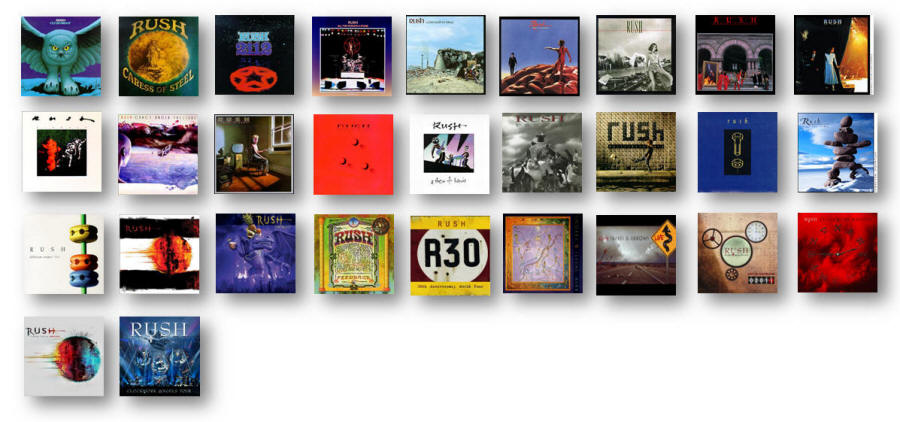
Fly By Night - AndyO rating: 3 stars out of 4
Released in February 1975
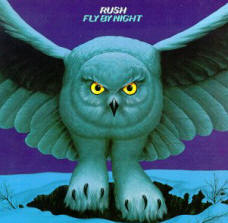
This is Neil's first album with Rush, but you wouldn't know it by the sound of things. The album opener "Anthem" begins with a bang, introducing the sound that would define Rush: intricate rhythms of hard-rocking, precise playing. "Anthem's" opening salvo contains some amazing beats; Neil starts on the snare and bass drum, and then sets up a groove on the hi-hat with some wicked, syncopated bass drum drumming.
As if that wasn't enough, there's "By-Tor and the Snow Dog" and those three machine-gun drum solos that are very, very hard to play. I often remind myself that Neil was 21 years old when he was making this stuff up―no ordinary drummer.
Caress of Steel - Andyo rating: 2-1/2 stars out of 4
Released in September 1975
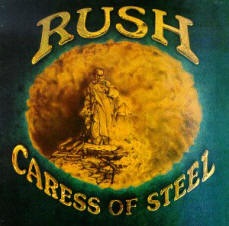
Caress of Steel is an album that, in many ways, foreshadowed what was to come from Rush. And while Caress may fall short of its grand vision, it's not a wasted effort. Many of the elements that would become essential to Rush's sound showed up for the first time here. Some of the firsts include:
- Songs exceeding 10 minutes. In this case, "The Necromancer" (12:33) and "The Fountain of Lamneth" (19:57). While "The Necromancer" builds on the J.R.R. Tolkien-themes explored in "By Tor and the Snow Dog", "The Fountain of Lamneth" is a more ambitious, original work exploring the perils of immortality (a theme that would show up in many other songs on later albums, including "Xanadu").
- Neil Peart's drum solo in "Didacts and Narpets." For this album, Neil added four concert toms that he puts to good use on this solo. Many of the patterns would find their way into Neil's drum solos on All the World's a Stage and Exit... Stage Left.
- Neil Peart's voiceover narration in "The Necromancer." This technique would be used again in "Cygnus X-1," and also in "2112: Grand Finale" with the "Attention all planets..." narration.
- Album artwork by Hugh Syme. Syme would go on to produce the artwork for every Rush album. While the importance of album artwork might not be as obvious in the age of digital music, it was crucial to establishing a band's image during the '70s and '80s.
2112 - AndyO rating: 3-1/2 stars out of 4
Released in March 1976

The story goes that the record company heard Rush was writing a side-long sci-fi epic and tried to stop it from happening. According to Neil, the band stuck to its guns and did what they wanted. And it became the breakout album for Rush. The band had found its voice and had established its core audience. Gone were the days of touring in a rented station wagon pulling a U-haul.
The "2112 Suite" (side one for those who bought the record) begins with "Overture"―chock-full of aggressive, stop-and-go rhythms that lead perfectly into "The Temples of Syrinx." It's such a perfect segue, Rush rarely performs one song without the other.
The drumming throughout "2112" is powerful and creative, matching the music at every turn. I've always been particularly stunned by the percussive pyrotechnics in "Grand Finale." To hear Rush's later versions of this in a live setting (especially during the Moving Pictures tour) is mind-blowing.
Side two of 2112 has a lackluster version of "A Passage to Bangkok," as well as some of my least-favorite Rush songs of all time: "Tears" and "The Twilight Zone." It's as if the band had put all its energy into that first side, which is fine with me.
All the World's A Stage - AndyO rating: 3-1/2 stars out of 4
Released in September 1976
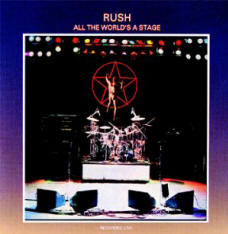
Massey Hall, 2112 Tour, 1976. What I would give to have been there. This is a sonic snapshot of the Rush in 1976, where they're most comfortable: playing for an audience. While the band had already shown amazingly-precise studio chops, their live performance brings out a groove that is sometimes buried in lush overdubs of guitars. We get to hear the band, warts-and-all, playing with a ferocious energy.
In particular, "By-Tor and the Snow Dog" and "In the End" seem emotionally charged and fresh. The medley that includes "Working Man", "Finding My Way", and the now-famous "Professor" drum solo shows how much the band has matured in their approach and includes new rhythmic interplay between Geddy and Neil.
A Farewell to Kings - AndyO rating: 3-1/2 stars out of 4
Released in September 1977
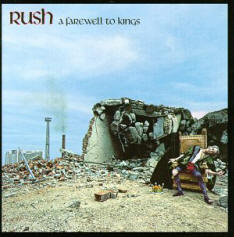
On A Farewell to Kings Rush set out to explore new types of sounds and arrangements. Keyboards play a more prominent melodic role in songs like "A Farewell to Kings" and "Xanadu," and the classical guitar shows up for the first time on the title track and "Closer to the Heart." Neil experiments with adding an array of new percussion: Tubular bells, bell trees, triangles, and anything else he can get his hands on. (Neil once called his use of percussion during this time "musical greed.")
Neil's creativity and new confidence are especially evident on songs like "A Farewell to Kings," "Xanadu", and "Cygnus X-1." He moves fluidly in and out of odd time signatures, and has started to leave more space for the music to breathe. One of the interesting developments on this album is the way the the drums are used to build tension during sections where band is playing a unison part. He uses this same approach in later songs, including the end of "Jacob's Ladder" and "The Camera Eye."
Back to TopHemispheres - AndyO rating: 4 stars out of 4
Released in October 1978

For me, Hemispheres is the album where Rush―and Neil in particular―brought their vision into focus. The musicianship is more confident, the production clear and crisp. And there's not a wasted song. Neil has said that the first seven or eight Rush albums were "experimental," and with this in mind you can see how mature Hemispheres sounds compared to those earlier efforts.
"Hemispheres" continues where "Cygnus X-1" left off. It's another concept piece that captures the cinematic quality of the band at its best. Yes, it's cerebral (literally) and, at times, pretentious, but the music is always rocking at a level that seems unattainable to most other bands. "Hemispheres" contains the first appearance of the the propulsive cymbal bell ride pattern that Neil would go on to use in countless other songs.
For all the seriousness on Hemispheres, this album contains one of Rush's finest instrumentals, "La Villa Strangiato," which has a more humorous framework. Based on Alex Lifeson's dreams, the 11 movements in this song take us through rock, jazz, fusion, cartoon music (listen to the section titled "Monsters!"), and everything in between. Neil said that this song was so hard, he couldn't play it in one take in the studio.
Also on this album are "Circumstances" and "The Trees." The latter has become an anthem of sorts, I suppose, for its simplistic lyrical imagery.
Postscript
As we later found out, Hemispheres was the album that pushed Rush to the breaking point. They'd been working non-stop up to this point, and the amount of concentration and energy required to make this complex album would turn out to be almost too much. Once the music was finally recorded, and Geddy went in to do the vocals, he realized it was in a key outside his stratospheric range. Even the mixing process would be a nightmare, with the band finally leaving England to take a week-long break, and then moving into a new studio.
As Neil said in an interview for Contents Under Pressure, "It was A Farewell to Kings where we started with a lot of the textured experiementation. And we took it to its apogee absolutely with Hemispheres, then decided tacitly [laughs] -- or, no, vocally -- that we wouldn't do that anymore. That Hemispheres was the end, that we didn't want to do side-long pieces, the overblown arranging, anymore."
Permanent Waves - AndyO rating: 4 stars out of 4
Released in January 1980
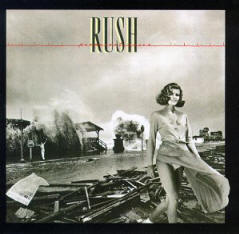
On Permanent Waves, gone are the side-long epics that are replaced by songs that compress Rush's trademark complexity and creativity. The album contains two of Rush's gems, "The Spirit of Radio" and "Freewill." Both contain displays of amazing musicianship, but there's also a stronger emphasis on melody and economy of songwriting.
The opening of "The Spirit of Radio" is a tour de force, with the guitar playing a repeating rhythm over bass and drum interplay. How they come together at the end has always been a mystery to me. The song, written as a tribute to a Toronto radio station, CFNY, sweeps through different movements that include Rock, New Wave, and Reggae (meant to simulate changing radio stations). There are references to Simon and Garfunkel's "Sound of Silence" lyrics ("The words of the profits are written on the studio wall.") This is a perfect Rush song―probably my favorite of all time.
And then there's "Freewill." Time change after time change, yet it doesn't feel odd. In the solo section, each member of the band releases a firestorm of chops that later prompted crowds in Rio de Janeiro to bow down. (Note that the beat and tempo in "Freewill's" verses are very similar to "Tom Sawyer's" groove.)
"Jacob's Ladder" is a song about an atmospheric image (when the sun slashes through the clouds), and it plays almost like a movie soundtrack. Neil's rudimentary snare work at the beginning of this song is particularly tasteful, as is the synthesizer interlude before the final movement.
For most bands, that would be enough. But Rush throws in "Entre Nous," "Different Strings," and "Natural Science" (another short epic, like "Jacob's Ladder"). With Permanent Waves, Rush started to cross a bridge into new musical territory, a journey that would be completed with Moving Pictures.
Moving Pictures - AndyO rating: 4 stars out of 4
Released in February 1981

This was the first Rush album to go multiplatinum, and brought the band to the attention of millions of new fans (myself included). All the elements that Rush had been working on since Hemispheres coalesced on Moving Pictures to form something interesting and noteworthy to popular culture.
On this album are some of the best songs Rush has written, "Tom Sawyer," "Red Barchetta," "YYZ," "Limelight," and "The Camera Eye."
Neil's creativity soars, from the groove on "Tom Sawyer," to the drum solo-like fills leading out of the solo section. Lyrically, there are existential explorations into the meaning of fame in "Limelight," and observations of walking around two very different cities in "The Camera Eye" (New York and London). There's the magic of "YYZ" and its Toronto airport Morse code rhythm that starts off the song. Everything about the album works, but most of all I like the production. The sound is clear and crisp. (Neil wore a microphone taped to his chest to get the "drummer's perspective"; I often wonder if this is how they got the drums to sound so good.)
If I had to pick one Rush album to recommend, this is it.
RUSH Moving Pictures - Deluxe Edition [CD + Blu-ray]
- An
excerpt from my blog
In April 2011, Rush released a 5.1 mix of Moving Pictures, and it got (mostly) rave reviews. I went out on the first day and picked it up, and could hardly wait to get home and put it on. As I listened on my home theater system, it felt like I was listening to Moving Pictures for the first time. But then I got to "Witch Hunt."
In "Witch Hunt," where the cowbell comes in (right before the "Features distorted in the flickering light" lyric), something sounded wrong. At first I didn't even know what it was, so I had to rewind. On second listen, I could hear it: Neil's drum part had been altered. What's really odd is the Stereo version on the Blu-ray doesn't contain the alteration.
No matter how much I wanted to love this pristine mix of Moving Pictures, I just couldn't get past those altered parts. Let's face it -- Rush fans love detail. And drummers love Peart's drum parts. It's obviously important to the band, too, since they recreate most of their parts live. The only problem I have with this new mix is the lack of transparency about what we're actually getting (if it was indeed intentional).
Exit... Stage Left - AndyO rating: 4 stars out of 4
Released in October 1981
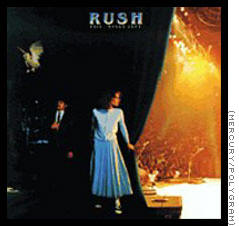
After four studio albums, it was time for Rush to do another live album. This one was recorded during the Permanent Waves and Moving Pictures tours. The stars lined up for the band on this release, as this album ended up being a "greatest hits" release right when Rush soared in popularity. Exit... Stage Left introduced new fans to the best of the Rush catalog in a live setting, where the band shines.
"The Spirit of Radio" leads things off (still my favorite version of the song). There's the sing-along in "Closer to the Heart," and a great version of "Jacob's Ladder."
I still remember my own journey to buy this album. I rode my bike in the dark for miles to the record store. Then, sweating and tired, I sat down and listened to the entire album. One of my strongest memories of that night is being somewhat frightened by the spooky, atmospheric first section of "Xanadu," only to be elated during the next section (where Neil plays his melodic cowbells along with Alex's guitar riff).
I also wondered how these three guys could make so much sound? Geddy Lee once called Rush "the world's smallest orchestra," and that's a good description. But it makes for a challenging night, especially for Geddy. He plays bass and also has to sing (no small feat); but then he also plays keyboards with his hands and keyboard pedals with his feet. But when I first listened to this album, I had no idea how they did it all.
Exit... Stage Left also contains the drum solo that made Neil Peart a household name. It's still one of his best. He lays down exquisite snare work that would make Buddy Rich proud, as well as those humorous cowbells. By the time he's done playing, he's pretty much redefined the modern drum solo. This is music, not just a drum solo. There are movements and themes. It's entertaining. He makes the drum solo accessible to non-drummers, following in the footsteps of Gene Krupa and Buddy Rich.
Signals - AndyO rating: 4 stars out of 4
Released in September 1982
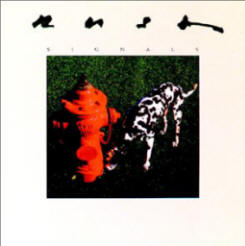
Signals was such a radical change in direction for the band that I didn't like it at first. Gone were the power chords on the guitar, replaced by keyboards. Lots of keyboards.
But when you listen closely, Rush is actually playing the same style of music as Moving Pictures, only arranged with keyboards and rhythm guitar. Neil's drumming is still as creative on every song. The sequencers haven't taken over yet (for more on that, see A Show of Hands).
I'm sure Rush lost a lot of fans with album, but they kept me. The Original Recordings Remaster of Signals is especially good, bringing out the guitar a little more.
There are fantastic drum details on every song on this album. Neil brought his "double-hand ride technique" to the forefront on "Subdivisions," giving the song a smooth, even feeling after the tension of the 7/4 intro. The fills that end the song are trademark Peart, a mini drum solo. "The Analog Kid" is one song where the guitar dominates, and remains a favorite of many Rush fans I know. I also think "The Digital Man" (one of the only Rush songs to swing) is an amazing display of musicianship and subtlety.
There are also two B-side gems worth noting: "The Weapon," which would radically influence Neil's playing on upcoming albums and "Losing It." The latter is a heartfelt song that includes a moving portrait of Ernest Hemingway (the Writer in the song).
Grace Under Pressure - AndyO rating: 4 stars out of 4
Released in April 1984

In many ways, this is one of Neil's finest creative efforts. The drumming is extremely interesting, and the lyrics achieve a level of maturity that is literary.
The title Grace Under Pressure is an expression originally used to describe the attributes of a Hemingway hero. Also sprinkled throughout are other phrases from the Golden Age of literature like "lost generation," "Brother, can you spare?" and "Absalom." The lyrics in "Red Lenses" are a blend of T.S. Eliot and e.e. cummings.
On the drumming front, Neil added electronics, which gave him a new palette of sounds, most evident in "Red Sector A" and "Red Lenses." Samples fire off in many songs, even when he's playing the acoustic kit. This configuration of acoustic and electronic drums eventually led to his rotating drum riser, which allowed him to face the audience when he played the electronics. (During the shows at Radio City Concert Hall before they recorded the album, Neil played the electronics with his back to the audience.)
This album continues the changes that started on Signals. For example, "Red Lenses" is a major departure, both musically and lyrically. When I first heard the keyboard melody in the middle section, I wondered if I was listening to a Rush song. But this willingness to experiment was the thing that made Rush so special and continued to keep them relevant during different eras of popular music.
You also have to admire the cover art for this album by Hugh Syme―definitely one of my favorites.
Power Windows - AndyO rating: 4 stars out of 4
Released in October 1985
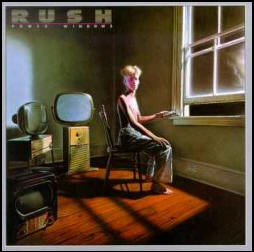
I was in college when Power Windows released, and it seemed to take the world by storm. The song "The Big Money" had a lot to do with it, with its pop sensibility and melodic hooks. I remember that my college roommate used to listen to a Seattle pop station that played U2 and The Cure, and when "The Big Money" showed up there, I knew things had changed.
This was Peter Collins' first effort producing Rush, and the results show that he understood where they wanted to go. Power Windows does a better job of balancing the keyboards and sequencers with bass, guitar, drums, and vocals.
"The Big Money" is a tour de force, fusing Rush's past hard rock approach with the new world of keyboard and sequencers. The hi-hat and cowebell work that opens the song is a perfect accompaniment. There are drum details hidden in the song, too, like the sample of coins jingling. And if you listen close, Neil's using a "clap trap" sample throughout the song. One thing that I never realized until recently was that Neil turns off his snare at the beginning and end of the song when he's using the "clap trap." I assume it's so he could get a timbale and snare sound.
What's even more impressive is that Neil keeps up this same level of drumming intensity and creativity throughout the entire album. There's the ending cymbal chokes in "Grand Designs" (a spontaneous decision made by Neil in the studio) during the rideout.
The drum part for "Mystic Rhythms," built around a repeating African-inspired rhythm, is the realization of a style and approach that Neil started working on in Signals. Neil plays "Mystic Rhythms" on his electronic satellite kit, but he also takes advantage of much of his acoustic percussion, including the gong bass drum, concert toms, wind chimes, and both Wuhan chinese cymbals (on his left and right).
Like Moving Pictures, Power Windows is one of Rush's most consistent, unified efforts. Rush would play much of the album during the Clockwork Angels tour, including "The Big Money," "Grand Designs," "Manhattan Project," and "Territories," much to delight of many fans. True to form, Neil made subtle changes his drum parts that are an interesting comparison to the album. In particular, "Grand Designs," shows a maturity in Neil's playing where he's sometimes playing less to support the song.
Hold Your Fire - AndyO rating: 2-1/2 stars out of 4
Released in September 1987

If there's an album where Rush started lose a bit of its soul, it's this one. The vocal melodies and keyboards started to overpower the three-piece sound that was so integral to the band.
Some people feel this is Rush's finest work. There are beautiful melodies everywhere on this album, but it's at the expense of some intensity. During the Permanent Waves through Signals timeframe, the music and the vocals had played equal parts, but on "Hold Your Fire" the vocal melody is dominant. There are still some interesting results, like "Force Ten," "Time Stand Still," and "Prime Mover." There's the introspective "Tai Shan" and "Mission" (the latter contains a modern day version of the "Free will" solo section). There's a wicked bass line in "Turn the Page." But somehow, it doesn't add up like some of the earlier efforts.
In retrospect, I think Rush became too controlled on this album, too safe. "Force Ten" was written as an afterthought in the studio, after all the other songs were done, and it probably should have been where they started.
Postscript
After the Hold Your Fire tour, Rush only played "Force 10" and "Time Stand Still" on other tours. But during the Snakes & Arrows tour, "Mission" made a rare appearance on the setlist. In a live setting with a more guitar-dominated sound, I was surprised how great "Mission" sounded. The same would be true when Rush brought back "Time Stand Still" and "Force 10" on later tours. My guess is that many of these songs would sound much better in a live setting today, partially with the way Alex Lifeson approaches his guitar sound, but also with the changes Neil has made to make his style more fluid.
A Show of Hands - AndyO rating: 2-1/2 stars out of 4
Released in January 1989

On the day this album came out, I remember sitting down with my brother and listening to it on CD (the first Rush album I'd ever bought on CD, actually). I remember thinking that it sounded perfect. And by perfect, I don't mean good. Machines are perfect, in that they can play flawlessly. People infuse music with personality, style, and even flaws. By adapting to playing with sequencers, Rush had lost its its soul.
Certainly, it was nice to hear some of the live versions of these songs. In the past, Rush's music shone much brighter in a live setting, but on A Show of Hands, it's clear that they'd lost part of the ingredient that made them who they were. One listen to "Subdivisions," and you can hear how Peart's perfection has a way of robbing the track of all its emotion.
The band had taken the direction they were going as far as they could. Even the drum solo with its jazzy horn triggers and tympani sounds feel a little too rehearsed. (I found out later they'd chopped a bunch of the solo off. When I heard the solo in its entirety, I realized they'd cut off the best part. I just couldn't believe Neil would let them do it, but then again, he said he didn't even care if the solo was on the album.)
Presto - AndyO rating: 3 stars out of 4
Released in November 1989
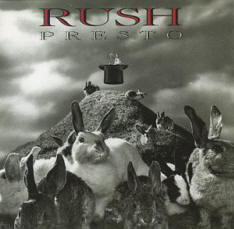
With Presto, Rush started to get back on track. Gone are some of the sequencers that drove the band, replaced with three-piece arrangements.
"Show Don't Tell" starts everything off, and even though the song has some keyboards, it's aggressive and strong. The drum groove is inventive and powerful throughout the song.
What makes this album different from the previous three is the band is doing more experimenting again. Whether it's the middle section of "Show Don't Tell" with its funky bass line to the tribal "Scars," the band was once again charting new territory. "Scars" is a fine example of how far Neil can take his electronics (he samples a bunch of ethnic drums and uses a foot-triggered snare sound). It's now a permanent fixture in his drum solo.
This album also contains "The Pass," one of the band's favorite songs. It's clear that Rupert Hine, the producer on this album, brings out the vocal melodies in a different way. This is abundantly clear in "War Paint."
Rather than surrendering to the machines, as they had done on previous albums, Rush reasserts an organic sound. The machines are still there, but they add to the organic approach.
Roll the Bones - AndyO rating: 3-1/2 stars out of 4
Released in September 1991

With Roll the Bones, Rush continued to get back to its core sound.
"Dreamline," the first track on the album, is one of the Rush best songs, and became the lead-off song on many Rush tours. The song is a fine example of "simple complexity," with Neil adding many drum details throughout. One of my favorites is the "sonar" sample before the second bridge.
"Bravado" is one of Rush's more tuneful songs, similar to "The Pass." There's some incredible four-way coordination on the drums at the end of the song, when Neil uses his double-surface ride technique, punctuated by tom-tom, snare, and hi-hat accents.
The instrumental, "Where's My Thing: The Gangster of Boat's Trilogy Part IV" marries Rush's penchant for complex instrumental music and melodies in a compact structure. This was Rush's first instrumental since "YYZ," and when I first heard it I thought it was quite a change. On some of the bootlegs, you can hear Geddy Lee's improvised vocal part on the monitors (but not on the PA), and I think it makes the song sound even better.
The theme of Roll the Bones is all about chance and luck, with some of the songs having more overt references, including "Ghost of a Chance," "The Big Wheel," and "You Bet Your Life."
What I most remember after hearing this album for the first time is that the melodies stayed with me. Somehow, Rush had found a way for their melodies and musicianship to coexist together. And without that tension, the melodies were able to achieve much more power.
Counterparts - AndyO rating: 4 stars out of 4
Released in October 1993

Counterparts proved that Rush could rock with the best of them. To put this in a historical context, Counterparts was written during the days of Grunge, a subgenre of Rock that brought together punk, funk, and classic rock into a guitar-oriented sound. The bands that popularized this sound were Nirvana, Pearl Jam, and Alice in Chains. This helped to pull Rush back to their roots even more than their previous two albums.
The results are magnificent. With a live mix that doesn't give up sonic details, the band tears through the album in a way they hadn't done since Moving Pictures or Power Windows. You know you're in for something different when you hear Neil Peart counting off, "1-2-3-4-1-2" at the beginning, with a nice drum intro (one of his best beats).
Next is "Stick it Out, a type of Rush song we haven't heard since "Tom Sawyer." The guitar erupting with feedback at the beginning tells us how heavy this album is going to be. "Cut to the Chase" adds some interesting production effects, especially with the drums.
What's great about this album is that it actually gets better with each song (with the exception of "Nobody's Hero," the token ballad). But "Between Sun and Moon," "Alien Shore," "Double Agent," and "Leave That Thing Alone" are simply brilliant.
Neil's drumming throughout the album is solid and inventive, made even more organic by the unique raw production. He doesn't miss an opportunity for interesting fills and details (listen to everything going on in the instrumental Leave That Thing Alone).
Counterparts [Hybrid SACD - DSD] - Released 2013
Test for Echo - AndyO rating: 2-1/2 stars out of 4
Released in September 1996
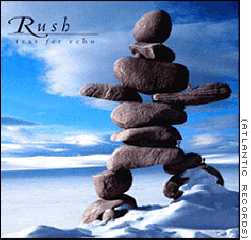
The title track "Test for Echo" starts out strong, with Neil playing some of his best drumming ever. And it seems like it's getting even stronger with songs like "Driven" and "Half the World." But after the latter song, the songwriting becomes a little flat. It's still good ― just not as good as what we've come to expect from Rush.
This is the album where Neil switched to traditional grip on his drumsticks. He did so because he realized the stiffness that had crept into his playing was ruining his feel. So Neil studied with a teacher, Freddie Gruber, and Freddie taught him to lay back and groove again. It took Neil over a year to build up this new technique enough to be able to play on a record. But after listening to this album now, I feel like he still wasn't ready. Neil wanted to integrate a Jazz style on this album ― but that style doesn't fit with Rush. At the very least, it was nice to hear Neil bringing in more nuance to his playing, something that got stronger during the Test for Echo tour.
There are still some interesting songs on the album. In addition to the first three, some of my favorites include "Dog Years," "Resist," and "Limbo."
This is also the album where Neil switched to DW drums, and there's an unmistakable deep sustain in the drum sound. The problem is the mix is muddy, so the drums seem to get lost.
Different Stages - AndyO rating: 3 stars out of 4
Released in November 1998

According to Geddy Lee, this album was released to buy the band some more time, after the tragic losses of Neil's daughter and wife. With Different Stages, Rush put together a great live recording, culled from both the Counterparts and Test for Echo tours. It also includes a bonus third CD concert from A Farewell to Kings tour.
While the song selection is good, and the sound is good, there are some strange drum mix issues that always turned me off to this album. There are also some tempo issues in "The Analog Kid" that I always notice. Some of these problems probably eist becaue Neil wasn't there to listen to mix.
Still, there's all of "2112" and a great drum solo coming out of "Leave That Thing Alone." Different Stages is still one of the best live Rush albums, and a great document of the 1990's Rush sound.
Vapor Trails - AndyO rating: 3-1/2 stars out of 4
Released in May 2002
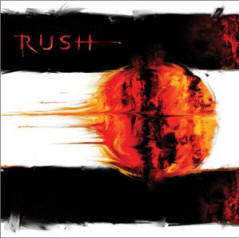
Rush had taken off five or so years before they recorded this album, and they spent 14 months working on it.
The results are superb. There's never been a stronger statement of Rush saying to the world, "We're back!" Starting "One Little Victory" off with Neil's thunderous drumming was a great idea. This is one of Rush's best songs.
Some of my other favorites are "Ceiling Unlimited," "Ghost Rider," "Secret Touch," "Nocturne," and "Freeze." All of these songs represent strong songwriting and a lyrical universality that hadn't appeared on Rush albums in a long time.
The only problem with the album is the production. It's well documented on the Web that this album suffers from too much compression and distortion. There's an unfinished quality about the mix that sent some fans back to the store. I never felt that strongly about it, but I did think there were problems.
In the end, I didn't care about the flaws. I was glad to have the band back together writing aggressive songs, and happy to hear Neil's drumming again.
Update:
Retrospective 3
(released in 2008) contained two remixes of Vapor Trails songs,
including "One Little Victory" and "Earthshine." It's only after
hearing these remixes that you realize how much better these songs
can sound when they're able to breathe.
Vapor Trails Remixed
completed the job of remixing the entire album.
Rush in Rio - AndyO rating: 4 stars out of 4
Released in October 2003

Rush in Rio is unlike any other live Rush release. It's hard to separate the CD from the DVD (they are the same concert), except that there are extra bootleg tracks of "Between Sun and Moon" and "Vital Signs" on the CD and a different 5.1 mix on the DVD.
All I can say is the crowds in Rio put all other crowds to shame. They sing along to every word and interact with the band throughout the concert in very unique ways. It's clear that this is where some of the biggest Rush fans live.
The other interesting thing about this album is this is the first time Rush has put out a full concert ― the whole enchilada. It takes three CDs, but who cares?
The band is at the top of its game throughout the whole performance, especially Neil. It's interesting to hear him re-imagine the drum parts for songs like "By Tor and the Snow Dog," "Cygnus X-1," and "Working Man."
For me, listening to this album brings back memories of seeing Rush at that opening Hartford, Connecticut, show with my friend Monica, as well as the second night at Montage Mountain in Scranton, Pennsylvania. The second concert, while not as flawless as the first, had a kind of magic to it that I'll always cherish.
Feedback - AndyO rating: 3 stars out of 4
Release date: June 29, 2004

I never thought I'd see the day when Rush would play covers. But all the songs on Feedback are near and dear to the band's heart. For their 30th Anniversary, the band wanted to give their tribute to the songs that inspired them to start playing.
The songs selection is eclectic. I have to admit, I was only familiar with about half, but I've never been a huge fan of sixties music.
The only issue I have with the album is the production. Like some of the earlier Rush albums, the guitar overdubs seem to obliterate the drum sound. In addition, Rush seemed to have a difficult time mixing Neil's DW drums until around Snakes & Arrows.
My favorites on the CD are: "Summertime Blues," "The Seeker," and "For What It's Worth."
R30: 30th Anniversary World Tour (Live):
AndyO rating: 4 out of 4 stars
Release date: November 22, 2005

Snakes & Arrows:
3-1/2 out of 4 stars
Release date: May 1, 2007

Snakes & Arrows Live:
AndyO rating: 4 out of 4 stars
Release date: November 22, 2005

Time Machine 2011: Live in Cleveland:
AndyO rating: 3 out of 4 stars
Release date: November 22, 2005

Clockwork Angels:
AndyO rating: 4 out of 4 stars
Release date: June 12, 2012

Vapor Trails Remixed: AndyO rating: 4 out of 4 stars
Release date: August 1, 2013
Reviewed: Thursday, October 03, 2013
After getting teased in 2009 with two remixed songs on Rush Retrospective III ("One Little Victory" and "Earthshine"), we now have a fully remixed Vapor Trails.
My short review: Go out and buy this one. Now.
For this project, Rush hired producer David Bottrill. Geddy said in an initial press release on Rush.com: "David Bottrill's remixes have finally brought some justice and clarity to this deserving body of our work. Every song has been given a new life, from the fire of 'One Little Victory,' 'Secret Touch, and Ceiling Unlimited to the melodic musicality of 'Sweet Miracle' and 'How It Is'... these songs have been redeemed. Thank you David!"
I'd also like to thank David. Listening to his remix of Vapor Trails is a revelation. The most important thing he's done is lift the fog of noise that shrouded every song in the original mix. Hearing these changes, you start to realize how difficult it must be to mix an album -- especially one like Vapor Trails.
Here are a few of my impressions after a few listens:
The drums are much cleaner and separated. Much of this has to do with the bass and snare, which were previously lost in a wall of guitars, bass, and vocal harmonies. There are drum details throughout this new mix that seem to jump out now. A few examples from "Ceiling Unlimited" include:
- The tom hits around the :55 and 2:03 marks
- The fill around the 3:30 mark
Vocal harmonies have been simplified and focused. I can actually hear the lyrics now. It's interesting how just being able to hear what Geddy is singing (and what Neil wrote) gives the songs much more power.
Alternate vocal melodies help create a more varied soundscape. In the case of the chorus in "Nocturne," using a lower vocal melody creates balance in the entire song. You can also hear this technique in the verses of "Peaceable Kingdom."
Alex's guitars are dialed down to create more space in the mix. The previous mix almost seemed to be a sonic symphony of guitars. I'm guessing this was one of the most difficult things about the remix -- untangling all those guitar tracks and choosing between them. But once they are untangled, the music comes to life, and the guitar isn't competing with itself.
New guitar lines and melodies appear in the mix. In some cases, you'll hear a different guitar track in a song. In "Ceiling Unlimited", listen to the guitar riff/solo around 4:00 to hear something new. In "Out of the Cradle" at 3:45, there's a great counter-melody that you could almost hear in the original mix.
Geddy's bass is given a more equal place in the mix. What you hear on this remix is more true to what you hear at a live Rush show. In some places, the bass even dominates, like at the end of "Vapor Trail" or in the verses of "Secret Touch."
Vocal reverb effects are used effectively. In "One Little Victory" at the 3:07 mark, the reverb on the vocals helps connect the chorus and the bridge sections together better. On "Ghost Rider," the reverb at the beginning creates a much more haunting feel.
Bass drum sound: The famous "rising triplets" that Neil uses in many songs jump out now. Listen to the bass drum around 4:02 in "Freeze" for a great example. Also more prevalent are the double-bass fills. In "Nocturne" around 4:15 and 4:22, you can hear two fills that used to be buried.
All in all, it's a great remix and worth purchasing -- especially if you were a fan of the original release. For me, the three songs that have been redeemed the most include "Secret Touch," "Ceiling Unlimited," and "Freeze." But all the songs benefit in one way or another.
If you're like me, you'll probably start thinking about how a few other Rush albums could use this kind of treatment. While an album like Test for Echo isn't necessarily Rush's strongest effort, I can imagine a remix could bring out the strengths in same way as Vapor Trails.
Maybe some day...
Clockwork Angels Tour: AndyO rating: 2-1/2 out of 4 stars
Release date: November 19, 2013

In the early part of their career, Rush released a live album every four studio albums, and the occasional concert video (starting with Exit... Stage Left). But the economics of the industry have shifted to concerts and live videos. Since their return from hiatus in 2002, Rush has released 3 studio albums (not counting Feedback) and 4 live DVDs and CDs. This is great news for Rush fans, as there's been a detailed record of every Rush tour for the past 11 years.
And now we have the The Clockwork Angels Tour video (the fifth live release since 2002), which captures the stage show and set lists of Rush's 2012 and 2013 tours. This was a unique tour and included a lot of firsts for Rush (which is saying something when a band has been touring for almost 40 years):
- Rush performed with a string ensemble for the first time (which was also the first time any musicians joined them onstage during a tour for an extended amount of time).
- They alternated the set lists almost every night, swapping multiple songs instead of just one or two as they had on previous tours.
- Neil Peart split his usual 8-plus minute solo into three shorter solos.
- They played rare tracks from Grace Under Pressure and Power Windows, many of which hadn't been played in years ("Grand Designs," "The Body Electric," "Territories," "Manhattan Project," and "Middletown Dreams") and also brought back the instrumental from Roll the Bones, "Where's My Thing?"
- The stage lighting and design was stunning, and probably the best light show ever designed for a Rush show (hats off to Howard Ungerleider and Production Design International).
- To top things off, Rush was inducted into the Rock and Roll Hall of Fame between the 2012 and 2013 tours.
Back to Top
Bonus CDs
Rush - R30 - 30th Anniversary Deluxe Edition
AndyO rating: 4 out of 4 stars
Rush - Replay [3 DVD/CD Box Set]
This DVD contains Rush's previous three video releases in DVD format, including: Exit... Stage Left, Grace Under Pressure, and A Show of Hands. The three concerts look and sound great. This collection also contains a CD of the Grace Under Pressure. Note that A Show of Hands is the only DVD to contain a drum solo.
